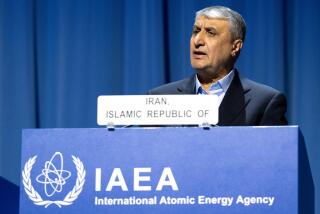U.S. Iranians seek a greater voice
- Share via
Patriotic Persian music blasted from the car that led thousands of demonstrators down Westwood Boulevard one recent afternoon, past Persian restaurants and bookstores. A plane hired by a local Persian TV station streaked overhead, flying a banner proclaiming: “We support freedom in Iran.”
The procession through the heart of the largest Iranian community outside Iran -- dubbed “Tehrangeles” -- had the feel of a massive coming-out party for a people who had been largely invisible to the rest of the U.S.
The violent crackdown against Iranians who continue to protest the outcome of a disputed election has galvanized Iranian Americans, especially in Los Angeles, like never before. The challenge now, community leaders say, is whether they can capture the passion aroused in many Iranian Americans to establish a greater voice in U.S. politics.
Iranian Americans are among the country’s wealthiest and most educated immigrant populations. They are partners at major law firms, senior executives at Fortune 500 companies and professors at distinguished universities. Yet only a handful have been elected to public office, none of them on Capitol Hill.
Activists and scholars say the community’s aspirations have been hurt by fractiousness, inexperience with grass-roots politics and a serious image problem. Most Americans know more about Iran’s radical clerics and nuclear ambitions than its cultural heritage.
Frustrated by their lack of political clout, some of the community’s most prominent members decided two years ago to form a lobbying and public relations group in Washington, D.C., called the Public Affairs Alliance of Iranian Americans.
“Our community has a tough time uniting on various issues,” said alliance spokeswoman Rudi Bakhtiar, a former CNN anchor. “While we’ve individually, all of us, been able to succeed in various fields, we have not managed to capitalize collectively on those accomplishments.”
She said it has taken time for Iranian Americans to understand the system and grasp the power of their vote.
Iranian immigration largely began when Islamic revolutionaries overthrew Shah Mohammed Reza Pahlavi in 1979. Subsequent waves included many who welcomed the ouster of a repressive monarch but became disillusioned with the fundamentalist clerics who followed. Some belonged to ethnic and religious minorities, others to political factions ranging from monarchists to communists.
U.S. census data puts their numbers at about 338,000, but estimates run as high as 500,000 in Southern California and 1 million nationwide.
Jimmy Delshad, who as mayor of Beverly Hills in 2007-08 was the most senior Iranian American elected official, said he thought it would be easy to run because of the large Persian Jewish population. But, he said, “When I went door to door, I couldn’t even get them to register to vote.”
“Any time you put your name on any list in Iran, you never know who is going to come after you,” he said. So he went to schools to speak to their children, who grew up here. They persuaded their parents to vote.
Bakhtiar said she hopes the enthusiasm stirred by events in Iran can be focused on domestic issues, such as increasing Iranian American representation, making friends on Capitol Hill and preventing discrimination in schools and on the job. But the public affairs alliance will not take a stand on how the U.S. should respond to Iran’s election or any other foreign policy issue.
“International issues tend to divide our community,” Bakhtiar said.
When it comes to their former country, the only thing most Iranian Americans can agree on is their distaste for the repressive tactics and extremist rhetoric of President Mahmoud Ahmadinejad, whose reelection last month was tainted by fraud claims. Over this issue, their mobilization was swift and powerful.
Thousands joined solidarity demonstrations. When foreign journalists were barred from reporting, Iranian Americans flooded social-networking sites with news and footage collected by friends and family.
The images of young, modern Iranians fighting for freedom and democracy shattered the stereotypes, said Masoud Kazemzadeh, an associate professor in the department of political science at Sam Houston State University in Huntsville, Texas. “This is very empowering for Iranian Americans,” he said.
Yet for all the unity on the streets, Kazemzadeh doubts it will translate into an ability to reach a consensus on a domestic agenda. “Within the same group everyone undermines and back-stabs over the smallest little things,” he said. “That’s part of Iranian political culture.”
Those divisions were evident at many demonstrations in Los Angeles, where green-clad supporters of Ahmadinejad’s main challenger, Mir-Hossein Mousavi, got into heated arguments with backers of U.S.-based opposition groups wanting to display the pre-1979 flag.
“That flag has come to represent the monarchy in Iran, and the government uses that as an excuse to crack down on demonstrators even more,” said Shahdad, a recent university graduate who did not want his full name published for safety reasons.
Those who carry the flag say it is a symbol not only of the shah but also all who oppose the Islamic Republic. They ridicule Mousavi’s young supporters for believing that change is possible at the ballot box.
Foad Pashai, secretary general of the Constitutionalist Party of Iran, said the priority now is to support the Iranian protesters, who will decide how they wish to be governed. But although the leader of the Los Angeles-based monarchist party said he would share a platform with Shahdad and other Mousavi supporters, it does not mean they will be working together any time soon. “Maybe we can walk in the same street,” Pashai said. “But we can’t walk together.”
--
Raja Abdulrahim contributed to this report.
More to Read
Sign up for Essential California
The most important California stories and recommendations in your inbox every morning.
You may occasionally receive promotional content from the Los Angeles Times.










